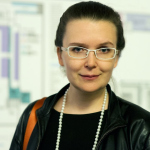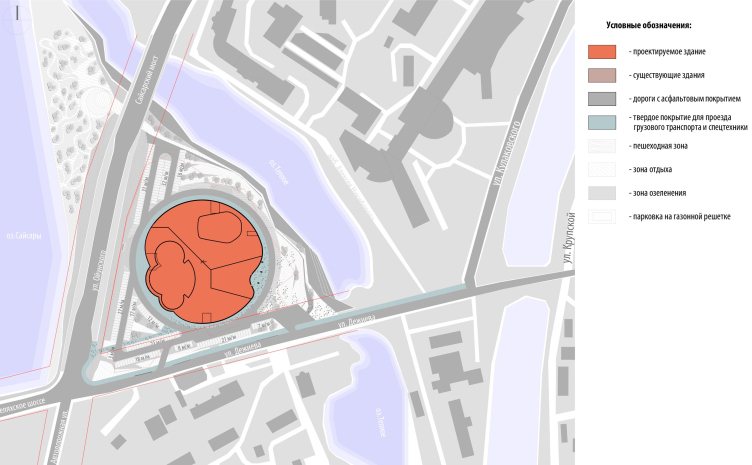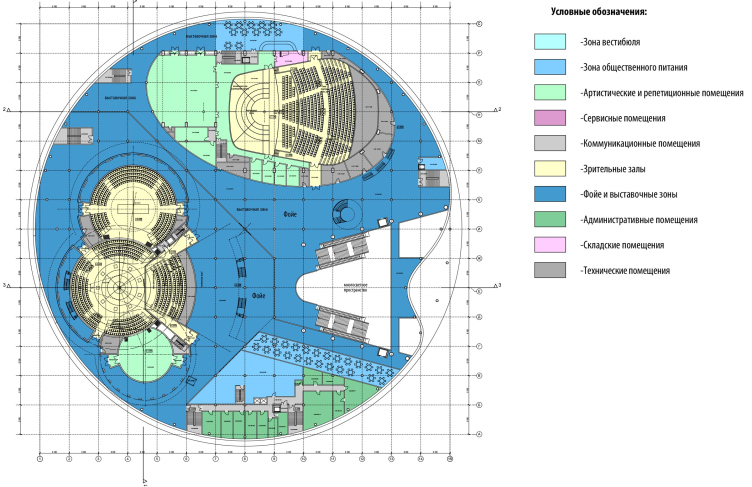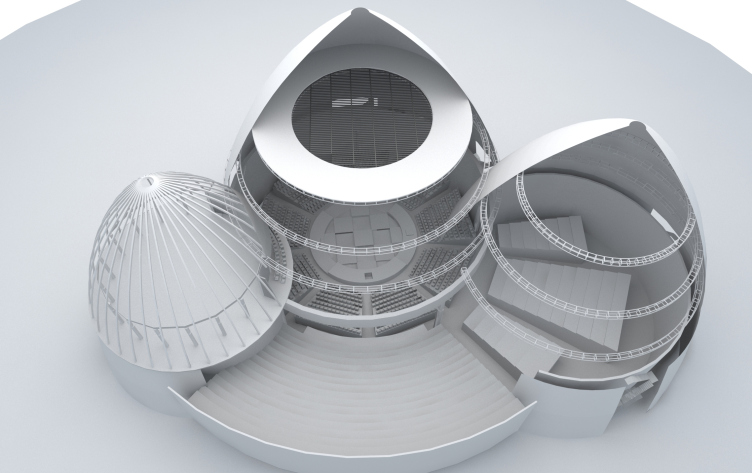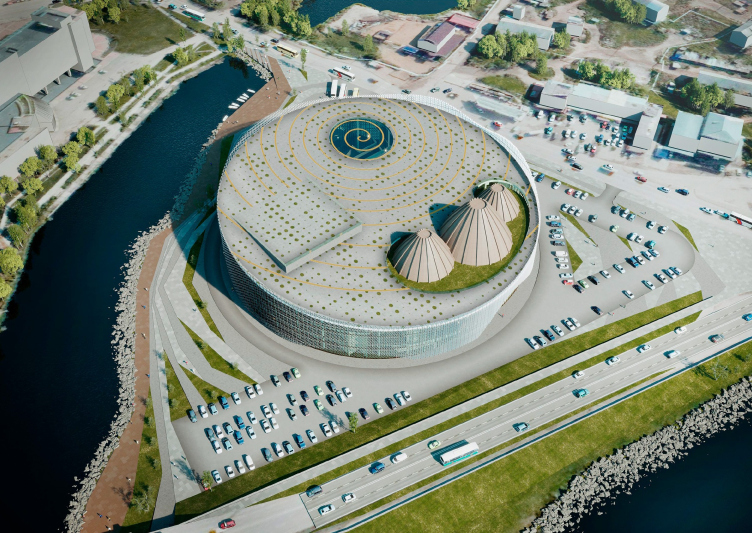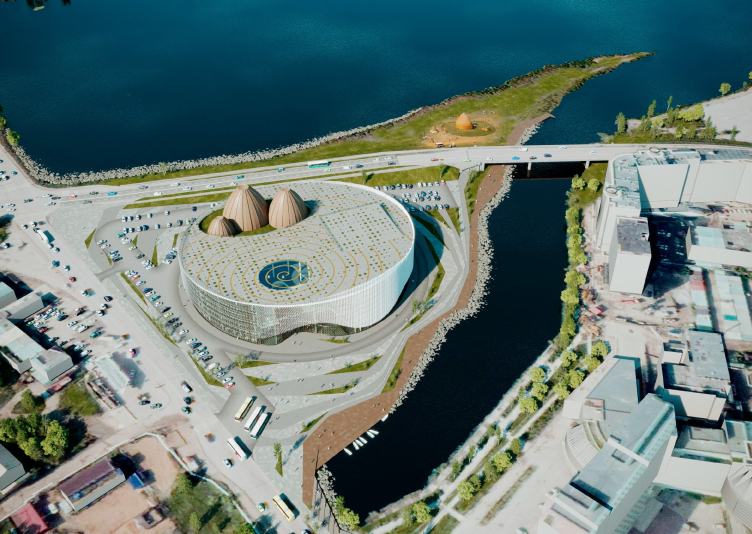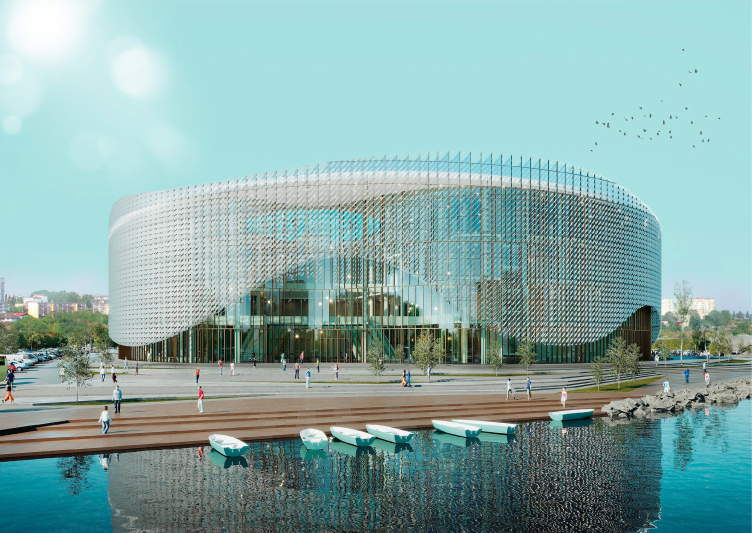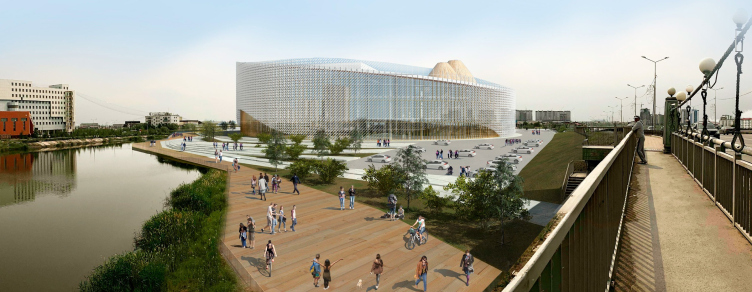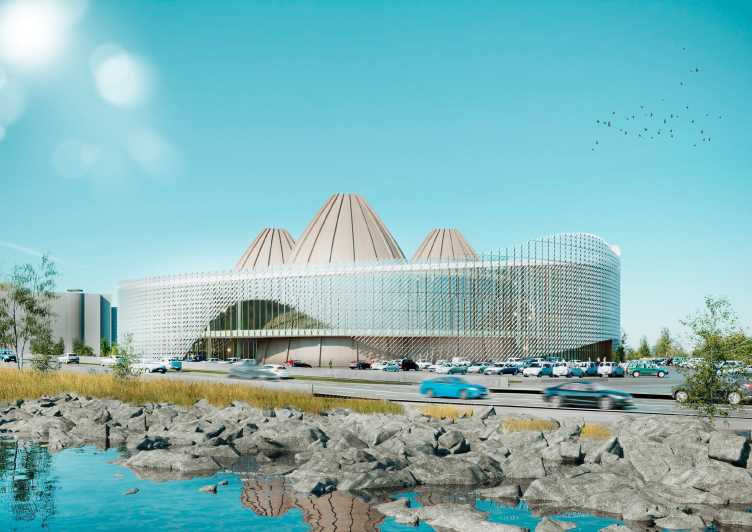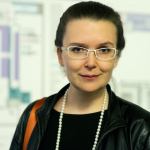By May 2019, the first versions of the concept were ready; in summer, a second version was discussed, and, finally, in mid-October, the project got an architectural and urban planning image, which made it possible to publish relatively extensive information about it. Nevertheless, the project is still being developed and updated, and the architects are promising to show a more detailed version later on.
International Center of Epics of Eurasian peoples in Yakutsk
Copyright: © Creative Union ‘Reserve’
The complex is situated in the southern part of Yakutsk, not far away from the city center, on the shore of the legendary Saisara Lake. The lake is considered to be sacred; the cape, where the Philharmonic Hall and the Arctic Center are about to be built, up until the 1990’s, was the place where Ysyhakh, the main national festivity, took place; in 2014, they also planned to build here a complex named “Zemlya Olonkho” – but back then they considered a much larger territory of 47 hectares. Today, the building occupies 2.2 hectares in the triangle between the Oikunskogo Street leading to the city center, the Dezhneva Street, and a sprout of the lake.
Location plan. International Center of Epics of Eurasian peoples in Yakutsk
Copyright: © Creative Union ‘Reserve’
The plan is based on a circle – a perfect shape that has an extremely important meaning in the Yakut mythology: the circle is the sun, the floor plan of a hut built around a fire, and the symbol of the yearly cycle – and it is not by chance that when Reserve Union took part in the competition for landscaping the Lenin Square in Yakutsk last summer, the main shape of the project was also a circle, the traditional protective charm with lots of superordinate ring openings.
There are two main parts inscribed into the circle of the plan – the philharmonic hall and the theater of Yakut Epos, with a common entrance zone, yet separate foyers, which allows them to function independently. Due to the fact that because of permafrost underground construction is not feasible, the mechanical rooms underneath the stages could not be deepened, and all of the spectator halls had to be elevated rather high up – 6.6 meters above the ground level – there are two broad staircases, flanked by escalators, leading upwards from the entrance zone and the reception area with the ticket offices.
The Center of Arctic Epos consists of three pavilions, whose shape is inspired by the traditional Yakut summer house – Uras. The pavilions are interconnected, two of them including stage spaces with spectator seats arranged in a circular order, the third one being a rehearsal studio. The central and the biggest pavilion of the Olonkho theater is united with the drama theater Sakha, which occupies the eastern sector of the circle: here, the spectator seats continue higher and further. The spaces can be divided and merged with the help of mobile partitions.
Plan of the 3rd floor at the elevation +6.600. International Center of Epics of Eurasian peoples in Yakutsk
Copyright: © Creative Union ‘Reserve’
One of the schemes for positioning the halls of the Olonkho and Sakha theaters. International Center of Epics of Eurasian peoples in Yakutsk
Copyright: © Creative Union ‘Reserve’
The roof is designed as an operated one; there will be festivals organized upon it; the circular skylight, which lightens the entrance zone by day, symbolizes the lake, while the whole roof is likened to Alaas – a giant meadow amidst the Taiga, the result of melted permafrost with a peat lake in the middle and arable land around it; historically, alaases were the basic units of Yakut agriculture and settlement. By the way, the glacier lake, also circular, as a rule, and the circular meadow with tasty grass for the horses – explain to a large extent the meaning of the circle for the Yakut culture and mythology.
International Center of Epics of Eurasian peoples in Yakutsk
Copyright: © Creative Union ‘Reserve’
Here, on the roof of the philharmonic hall and the theater, the lake is just tiny, and the “uras” huts are larger, yet the picture is still recognizable: one can see the “lake”, the “meadow”, and the hipped roofs, and the picture becomes part of the scenario of the entire building. It may seem as if a perfect cylinder were cut out from the permafrost – with some space-age laser, for example – and was pushed up from the ground, so the village ended up on the roof, while the chthonic forces that supported it turned into the power of theater and music; gods, and especially shamans in many cultures travel towards the underground fire, while in this specific instance it turns out that it was taken out from the earth and laid as the basis of, let’s say, performative creativity.
International Center of Epics of Eurasian peoples in Yakutsk
Copyright: © Creative Union ‘Reserve’
The cylindrical volume of the complex rises slightly eastward, where the entrance is situated, oriented, in full accordance with the cultural patterns of the Yakut epos, towards the sunrise. The facades are double bound: on the inside, the walls are made of glass, which is meant to ensure plenty of light in the foyer and the lobby; on the outside, the walls are covered with a mounted casing. Down below, its contour rises in large waves that look like arches – everything works together to create a hovering effect, responding to the theme of water, at the same time strengthening the “iceberg” effect – the likeness to the fragment of permafrost cut out from the soil. The building is icy and iridescent; the glass in its basement looks like pure ice that trapped the outlines of the floors and pillars, clearly discernible from the outside.
International Center of Epics of Eurasian peoples in Yakutsk
Copyright: © Creative Union ‘Reserve’
The entrance is made deeper by a smooth parabola – a volumetric wave that recedes before the small plaza. The outlines of this plastique depression behind the screen of the outside casing look like yet another linear wave, kicking into play, based on the gauze semi-transparency and visual permeability of the building. We will note here that the outside casing does not bend at the same time, “holding” the diameter; the waves are pretty geometric, the shape is large, yet at the same time delicate and pure, all of the analogies and parallels staying within the confines of the abstract, and not indulging into any literal interpretations.
International Center of Epics of Eurasian peoples in Yakutsk
Copyright: © Creative Union ‘Reserve’
There will be a broad wooden boardwalk running along the shoreline, and a small venue for open air events. At some point, the architects were considering the construction of a full-fledged stage next to the water, yet later on they refrained from that idea.
International Center of Epics of Eurasian peoples in Yakutsk
Copyright: © Creative Union ‘Reserve’
In the first May version, the structural and ethereal character of the solution – the glass cylinder with a wavy ribbon cast over it, hovering in the air – could be read ever more clearly: the casing was composed of white vertical lamellas that formed clear and transparent strokes, reflected in the curves of the glass surface, resonating with the lines of the framework of the glass walls with a rhythm of pillars inside. All of this served to create a “mirage” image, and, to a certain extent, “dematerialized” the building, setting at the same time the appropriate tone of the graphic discipline and completion. The bands were rather large to be seen from a distance, yet still thin enough to hold the volume together. This version also provided for a thin cornice line on top, marking the edge of the roof.
Also, in the first version, the mutual positioning of the spectator halls in respect to one another was different: the group of theaters was lined up in one row right of the entrance, the philharmonic hall was on the left; the two modules were separated by the ravine of the atrium, elongated and overlooking the sacred lake with its end opposite from the entrance. As a result, the lobby was getting more ambient light from above and could claim a more important role of the indoor plaza, something like a covered public space between the theater and concert halls.
However, one of Andrey Borisov’s requirements was about creating a panorama of all the three uras pavilions from the side of the lake, and the theater was moved from the north over to the west, the arrangement of the elements inside the circle changing, and the plan getting a configuration looking like an hourglass: one trapezoid part from the entrance is narrowing, the other, closer to the lake, is widening.
The facade with vertical lamellas was also another point of concern of the client’s – due to the fact that nearby, eight hundred meters away from the philharmonic hall, the building of the complex “Russia, My History” was built, whose facades also sport light-colored verticals, even if differently constructed. Then the client had a desire to include in the project, in addition to the already-employed imagery, rather rich as it is, a reference to the Lena Pillars, the most magnificent natural monument in the Sakha Republic. This is how two more versions of the project came about: one with an opaque golden pattern resembling, albeit remotely, the famous rocks, like a pixel picture, the other – with a media screen, which would broadcast the images of this natural sight, along with billboards and live broadcasts.
In fall, the “orange” version with the Lena Pillars was replaced by a lighter one – now the outside screen of the facade consists of aluminum ovals, mounted diagonally on the grilled octahedral structure, which makes it possible to mount the outside surface at a rather large distance from the glass of the main volume.
The resulting structure must show glitter, yet not like in the first version, where it looked like ice with organized streaks, but rather like snow or cloud. And transparent, too: from the side of the lake one can clearly see the imposing, slightly bent, buildings of the theater, belted by a glass floor and something like a scarf or a necklace rising up towards the east. The picture is half traditional, half cosmic.
International Center of Epics of Eurasian peoples in Yakutsk
Copyright: © Creative Union ‘Reserve’
International Center of Epics of Eurasian peoples in Yakutsk
Copyright: © Creative Union ‘Reserve’
